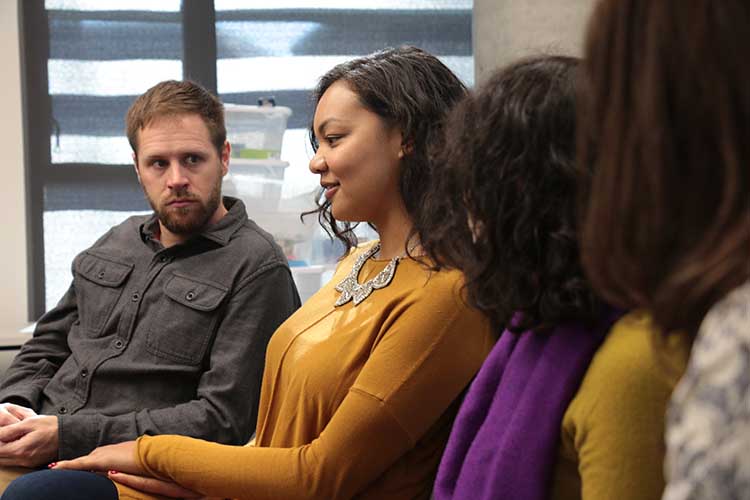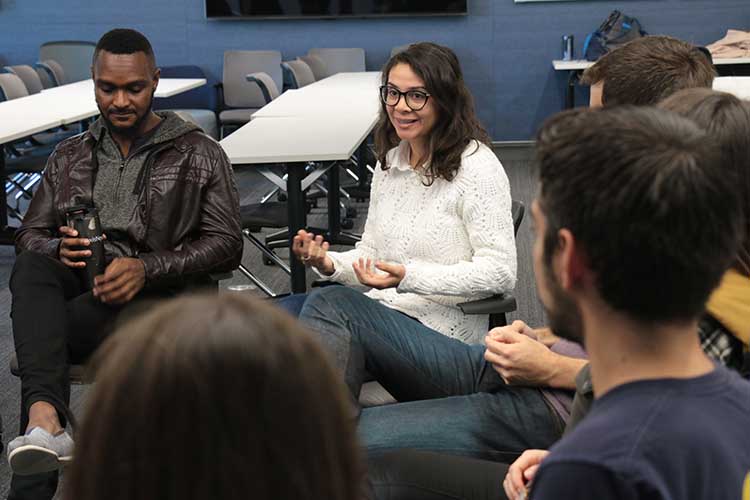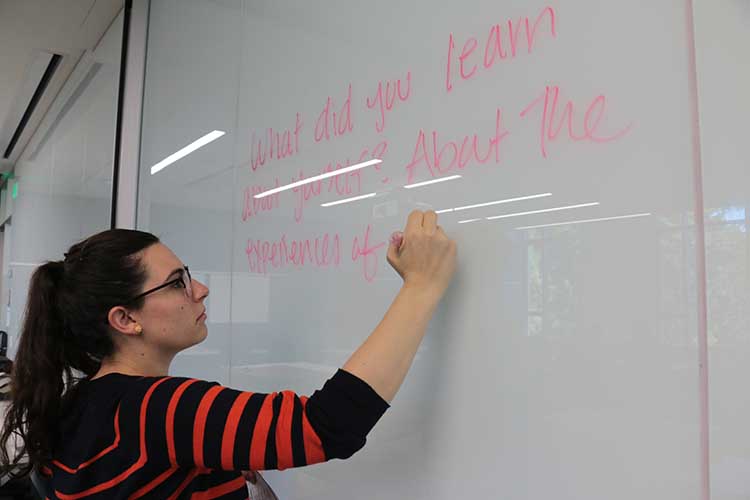When Anne Kramer, MBA 18, attended the first session of a new seminar called “Dialogues on Race,” she was surprised to learn she’d spend the initial two weeks in a group with other white students. They were asked to discuss the first time they realized they were white, past experiences talking about race, and hopes and concerns for the class—before coming back together with the diverse class group.
“It felt weird and uncomfortable (for students to be divided up by race), but it made it very real,” Kramer said. “We were there not to ignore differences, but to understand differences and then have a dialogue about them.”

Reflecting on identity and power
Bringing that discomfort into the open was exactly the point of the student-led independent study seminar, launched this fall in the Full-time MBA Program. A survey led by MBA students in the Race Inclusion Initiative last year found that while 90 percent of their classmates believe that understanding racial dynamics is a key component of effective leadership, less than half say they are comfortable talking about race.
Inspired by a class called “Diversity in the Workplace,” Liz Koenig, MBA 18, drafted a plan to push classroom discussions on race even further. That became “Dialogues on Race,” a ten-week seminar aimed at creating a safe space for students to develop better skills for engaging in these conversations in their careers and lives.
“The ability to reflect on identity and power is a core competency, certainly for being a leader of any kind, or a manager of human beings,” said Koenig.
Pete Johnson, Assistant Dean for the Full-time MBA Program & Admissions, said the seminar builds on elective MBA courses such as “Diversity in the Workplace,” “Groups and Teams,” and “Business Case for Investing in Women,” which all explore ways to understand diversity and help students to develop management skills. Berkeley MBA students can develop student-initiated or independent study courses under the guidance of a faculty advisor.
“I’m thrilled that our students are using the independent study option to further enhance their ability to lead diverse teams and organizations,” Johnson said.

Balancing the class
Koenig and co-facilitator Om Chitale, also MBA 18, actively recruited a broad cross-section of students, and chose the class times based on when the most representative groups were able to enroll. There was so much interest that they added a second section, facilitated by Atim Okorn, MBA 18, and alum Patrick Ford, MBA 17, who had co-led the Manbassadors male ally program as a student. Asst. Prof. Drew Jacoby-Senghor acted as faculty sponsor.
In the end, the classes included about 60 percent white students and 40 percent students of color—a ratio similar to the racial and ethnic breakdown of the US population. Aside from two students with scheduling conflicts, all 28 students who applied were able to enroll.
“We didn’t want to end up in a situation where there was anyone who felt like they had to speak for a group,” said Koenig.
Erin Gums, MBA 18, said she enrolled because she realized she had a part to play in the conversation. Growing up identifying as both black and Pacific Islander, and working for years in education, she had thought about and talked about race her entire life—but was not having those conversations with her white peers, she said. This was a group she trusted enough to open the conversation.
“This experience was something I will always remember as a very important part of my time here at Haas,” said Gums, who also serves as VP of Diversity for the MBA Association. “I have chosen to be in the business world and be a business leader, and I have chosen to play a role in pushing for a less racist society. This course helped me put words to some ideas that I’d never articulated clearly, and to practice skills to have these sensitive conversations with people in less comfortable environments in the future.”
Burning questions
According to Chitale, the class took on a life of its own. As students provided feedback from week to week, the facilitators adjusted the course content and structure—for instance, by replacing one of the final sessions with an open two-hour discussion of “burning questions.”
“One thing that was interesting was how the goals of the class evolved,” said Adrian Williams, MBA 18. “At first it was giving people practical, tactical tools on how to attack issues of diversity and inclusion outside of the classroom. Over time, we realized some of the issues were a lot more nuanced than we thought. It also became apparent that I had some blind spots that required me to think through some of my arguments.”

For Kramer, this class was the first opportunity she’d had to engage in deliberate conversations on race. “The concept of race in the US was something that I didn’t see in my everyday life growing up,” said Kramer, who spent much of her childhood in London and Hong Kong. “Conversations that I might have shied away from before, or uncomfortable things that people might have said before, now I’m willing to actually ask: ‘What makes you think that?’”
Kim Ayers, MBA 18, said it was eye-opening to learn that her classmates of color were dealing with hurtful interactions related to their race on a regular basis. “The fact that I was largely blind to that until we directly engaged in this conversation was really powerful to me,” said Ayers.
Awkward and intense moments
Gums said there were some awkward and intense moments—which she believes are inevitable for change to occur. “My fluency with these topics is going to be greater than that of people who have just started thinking about these issues for the first time in their lives, and that’s okay,” she said. “We need to recognize that people will mess up and say the wrong thing, but that shouldn’t prevent you from continuing to have these difficult conversations.”
Ultimately, “issues of race and racism are so complex and messy—there’s no one approach or one good way to solve it. If it were that simple we would have figured it out by now,” Gums said. “There are many roles we need people to play to address systemic issues.”
The course is one of several student-led initiatives aimed at helping students develop more fluency in addressing racial dynamics. Students in the Race Inclusion Initiative—a research-based MBA student effort to increase the number of underrepresented minorities in the program and make the climate welcoming for all—organized “Dialogues over Dinner” this month, where students were asked to read an article or watch a short video on a race-related topic and then discuss it over small group dinners. All ten of the dinners were facilitated by students from “Dialogues on Race” eager to put their learning into practice.
Koenig and her co-facilitators are planning to lead “Dialogues on Race” again in the spring. It garnered rave reviews, and they’ve received over 47 applications for the spring section. “My hope is that we get to a place where this is considered core to the fabric of any MBA program,” she said.
“Businesses have power and influence in society,” said Chitale, the co-facilitator. “If we can get business leaders to be open and vulnerable on ideas of identity and power and privilege, I truly believe that’s going to have an impact on society.”